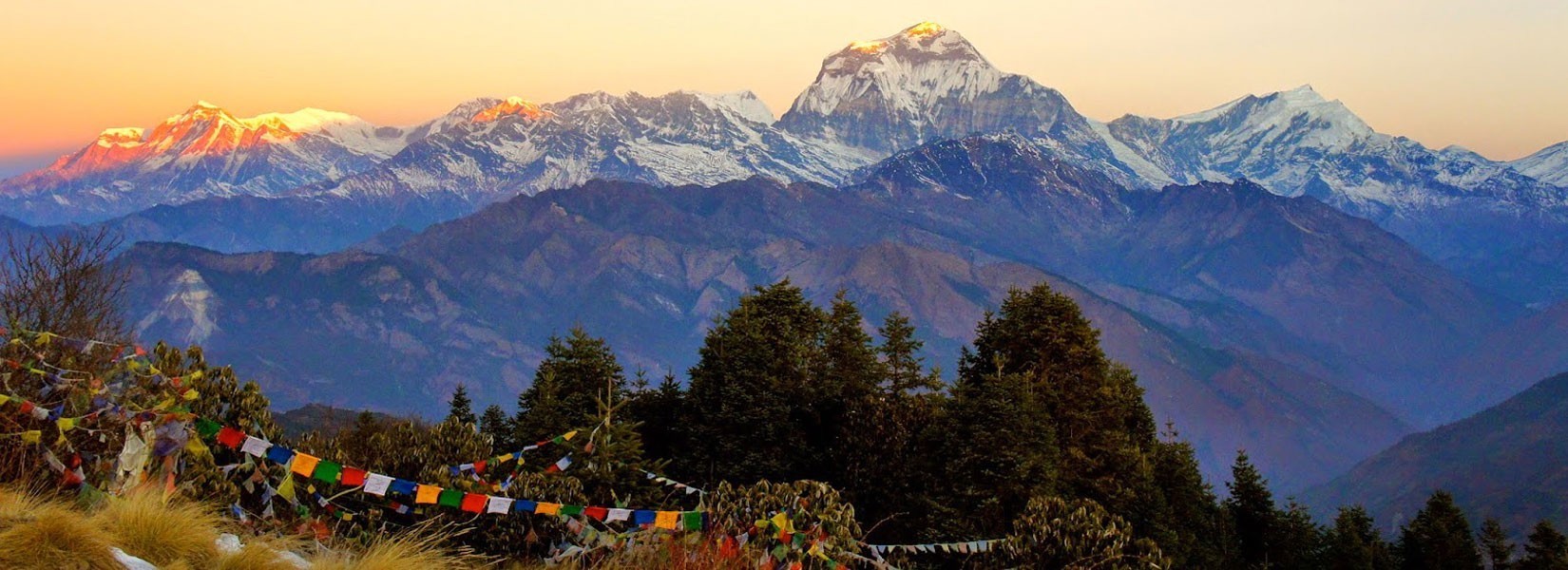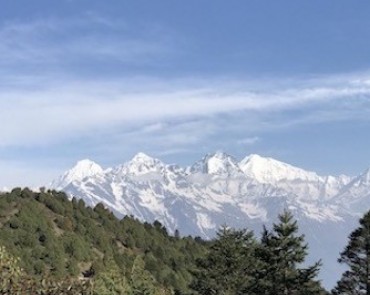Short treks in Nepal provide you with the lifelong memory of the natural wonders and socio-cultural uniqueness and richness. These trekking packages are most appropriate for those people who are busy, so, can manage very limited time to spend in Nepal. Within the very tight schedule, the national and international tourists can enjoy the alluring mountain vistas, and dense forests. While walking along the comparatively easy and moderate trekking trails, the visitors get the joy of plants, birds and animals.
Nepal is the home for the Great Mountains and Lesser Himalayas including the world’s highest peak, Mt. Everest. High altitude human settlement areas having their intact culture and traditional practices, attract hundreds of thousand tourists every year. As it is extended in lowland, middle hills and high mountains, you can experience all types of major climatic zones. The variation of land structures has created vastness in lifestyle, food items, vegetation and wildlife.
While doing short treks in Nepal, you can splendid sunrise view of the Himalayas, lush valleys, cultivated lands and dense forests. Sparkling snowcapped peaks of the Northern Himalayas bordering with Tibetan Plateau are seen from all the trekking regions of Nepal. As Nepal has been a abode for more than 125 different ethnic groups, 123 recorded languages, every trekking destination you plan to visit gives you unique culture and tradition.
Similarly, you can have the experience of homestay facilities during short treks in Nepal. You get a better chance to spend the time with the host families and have their distinct rites and rituals. The guests can also involve in their everyday activities and sometimes their feasts as well as festivals. The food they serve during the community-based treks is absolutely organic and hygienic that you won’t forget during your life. You can even learn to cook their food items that you can share with your people back in the home country.
Most of the short treks in Nepal are planned to guide you along the comfortable trail to the destinations nearby the city area. During these treks, you not only have the rural lifestyle and its authentic parts but also the urban areas. This is to say, if you choose the short treks nearby Kathmandu valley, you can visit the UNESCO World Heritage Sites located here. The World Heritage Sites in the Kathmandu Valley are Patan Durbar Square, the Monkey Temple, Pashupatinath Temple, Bhaktapur Durbar Square, Bouddhanath Stupa, Kathmandu Durbar Square and Changunarayan Temple.
Orbit Alpine Adventure organizes a large number of short treks to make you dream to see the Himalayas come true. Some of the most popular short treks designated from our agency are Balthali Village Trek, Ghandruk Trek, Kalinchowk Temple Trek, Ghorepani Poonhill Trek, Lower Mustang Trek, Khopra Danda Trek, Pikey Peak Trek, Everest View Trek, Langtang Trek, Mardi Himal Short Trek, Everest Base Camp Short Trek, Annapurna Base Camp Short Trek, etc. To get more information regarding the short treks, contact us at www.orbitalpineadventure.com.
1. What are the most popular short treks in Nepal?
As Nepal is a mountainous country having around 1,310 peaks including the highest peak in the world, Mt. Everest, it is the hub for trekking. Therefore, the avid trekkers from all over the world visit here in their right time to trek through the rural areas. There are many trekking regions having a lot of short treks in Nepal, however, the most popular are: Balthali Village Trek, Ghandruk Trek, Kalinchowk Temple Trek, Ghorepani Poonhill Trek, Lower Mustang Trek, Khopra Danda Trek, Pikey Peak Trek, Everest View Trek, Langtang Trek, Mardi Himal Short Trek, Everest Base Camp Short Trek, Annapurna Base Camp Short Trek
2. Why are the short treks in Nepal designed?
Short treks in Nepal are special trekking packages designed by the trekking agencies to help the visitors to choose the right one. Actually, these packages are for those visitors coming to Nepal with very limited time pressure and budget. Although you don’t have much time and budget to spend but want to experience the natural and cultural wonders of Nepal buy booking these treks.
3. How are short treks in Nepal beneficial for me?
These trekking packages are developed for those travellers who have very limited time and budget to spend in Nepal. They are beneficial for you as you can see the Himalayan views, lush valleys, high altitude villages, typical lifestyle, culture and tradition. You can have all the natural and cultural characteristics of a particular region by booking the short treks with the agency. You get the best experience of snowcapped peaks, alpine forests, mountain villages at the most reasonable cost.
4. What type of trekking are the short treks in Nepal?
Nowadays, most of the short treks in Nepal are teahouse trekking as the infrastructures of tourism have been developed. You don’t have to worry about spending a large amount of budget to manage the crew, camping equipment, trekking gears and porters to carry your load. You can visit almost all the trekking regions of Nepal by spending the nights at teahouses and eating the food prepared by the owners.
5. Do I need previous trekking experience for doing short treks in Nepal?
For the short treks in Nepal, it is not mandatory to have previous trekking experience as the trails are comfortable and well defined. However, if you choose the trekking packages to the high mountain regions like Everest, previous trekking experience will be fruitful. If you have already done trekking in the Himalayas, you can walk comfortably for quite longer duration as well. If you are the beginners, you have to follow the instructions given by your trekking guide. Most importantly, you should walk with slow pace and taking enough rest to avoid Acute Mountain Sickness (AMS).
6. Do I need climbing gears for short treks in Nepal?
In fact, it depends upon the altitude you are going to reach during the short treks you have booked via the agency. If you are trekking towards the lower altitude region having no high passes, in fact, you don’t need climbing gears. On the other hands, if you want to cross the high Himalayan passes like that of Everest region three high passes, you must have it. Nonetheless, the short treks included on our websites don’t require climbing gears. You can enjoy the trekking with your backpack but need to carry thick clothing items to protect from snow bites.
7. Do I need to hire a registered guide and a porter for doing short treks of Nepal?
No, you don’t if you book one of the popular short treks with a trekking agency because they manage it by charging you in advance. Hiring a registered trekking guide and a porter is compulsory only when you want to trek through restricted areas of Nepal. Even in these short treks which are not restricted areas, we highly recommend you to hire a professional trekking guide and a porter if your baggage is heavy. The guide helps you in case of troubles like altitude sickness, reservation of teahouses or lodges and finding the right trekking track. There are so many cases when the international trekkers have missed the right trail and have died falling from the cliff or being looted by the bad people en route. We advise you not to count on some more budget because your security is our first priority.
8. What is the best time for short treks in Nepal?
You can do these short treks in Nepal all times of the year except in the high Himalayan region. As there is possibility of heavy snowfall and blockade of the trekking route in the high altitude, you may have difficulty. But in the lower Himalayan regions as well as the short treks around Kathmandu and Pokhara, you can do it always without any problem. But the best time for short treks in Nepal is spring and autumn when you can have clear view of the Himalayas and landscapes. Even in rainy season, Upper Dolpo and Upper Mustang trekking is possible as they lie in the rain shadow area.
9. Do I get altitude sickness during short treks in Nepal?
You know, there is always chance for altitude sickness as soon as you reach the landscapes higher than 2,500m. Most of the popular treks in Nepal doesn’t go much higher than 2,500m, so there is no chance for altitude sickness. But if you are doing Everest Base Camp Short Trek or any other region higher than 3,000m, you must always be careful. First of all, you should walk slowly without worry; then, you have to drink enough water and have hygienic food. You should carry the medicines like Diamox Oral in your backpack and follow your trekking guide who is well known about such circumstances. More importantly, if you feel like nausea, dizzy, short of breath and dehydrated, don’t hesitate to share with the guide. The guide helps you get rid of the AMS problems and contacts the agency if the case is severe.
10. What accommodation and food facilities are found during short treks in Nepal?
In the urban area, the facilities of accommodation and food are available as per your choice and appetite. But in the rural areas where you have only teahouse facilities, your luxury cannot be matched. They provide basic facilities of food and lodging as it is newly developing section on the one side and on the next, transportation facilities are really poor. But we assure you that the food items provided by the local people are really organic and hygienic. And next thing, we recommend you not to eat non-veg items in the high Himalayan region as they may not be fresh and hygienic. As Nepal is developing tourism infrastructures in the trekking regions, you should be flexible regarding the services.
11. Can I do short treks in Nepal solo?
Sure, if the short trek package you buy doesn’t have restricted areas. In the restricted areas, trekking for an individual trekker on your own is not allowed. You must be at least two persons in a group supported by a registered guide and a porter. More than this, you must have a special permit, which costs higher price with you. Nevertheless, we suggest you to hire a professional guide and porter to know more about the natural and cultural heritages of the particular region. And the guide helps you in case of unfavourable situations like accidents, altitude sickness or missing of the right trail.
12. How difficult are short treks in Nepal?
Actually, trek difficulty depends upon the trekking duration per day, altitude you gain, remoteness of the trekking trail and the destination you choose. If you want to do short treks solo, you may not be all information regarding these factors and as a result, it will be difficult. But you won’t have any difficulty in short treks if you book the package with Orbit Alpine Adventure. What you need to worry about is your physical fitness and mental readiness! Just be focused on getting the maximum joy from the nature and culture of a particular region.







